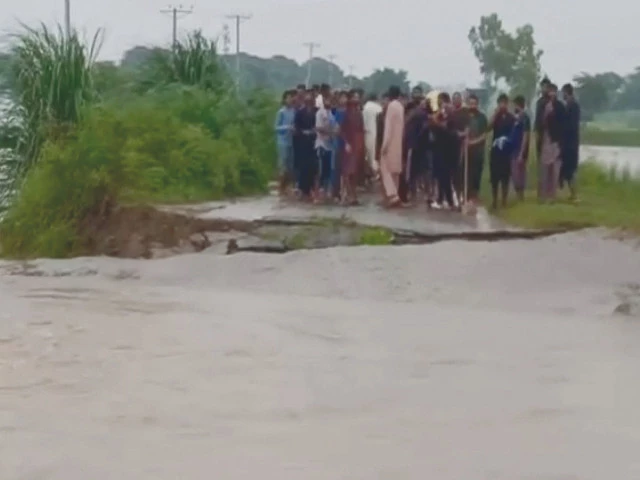Islamabad / Lahore:
The authorities placed on Tuesday the disaster management institutions and related agencies on “high alert” flood risks of flooding “exceptionally high” through Punjab, following a mixture of incessant monsoon rains, ice fusion and water release from India from multiple dams upstream.
Provincial and federal authorities have said that nearly 190,000 people had already been evacuated, the soldiers helping rescue operations in dozens of flooded villages. The National Disaster Management Authority (NDMA) warned that the following 48 to 72 hours will be critical as the strong precipitation continues and that the discharges of the dams are accelerating.
The last crisis comes as the Chenab, Ravi and Sutlej rivers – oriental tributaries in the Indus basin – increased at dangerous levels, threatening the agricultural heart of Punjab, which provides a major part of the country’s food.
The president of the NDMA, the LT GEN INAM HAIDER, told journalists in Islamabad that a large-scale evacuation campaign was in collaboration with the PDMA and the rescue of the PUNJAB 1122. “Nearly 190,000 people were moved to safer areas of high-risk areas along the Sutlej river,” he said.
“All the relevant departments remain on alert,” he added. He warned that the eighth spell during the monsoon season posed special dangers, as unusually strong precipitation was planned for districts that were generally dry.
“Excessive rains are expected in the areas of Sialkot, Narowal, Kasur and adjacent over the next two to three days. He urged the public to remain vigilant, avoid the low zones and strictly follow the opinions and official alerts.
According to the Punjab irrigation department, Marala Headworks’ entries on the Chenab have exceeded 400,000 brackets, with forecasts suggesting that the levels could reach 600,000 CUSCS on Tuesday evening – a “serious flooding” stage. Downstream and average to high to high flood rates have been reported to Khanki and Qadirabad.
The Ravi river also remains under pressure, the flood waters of the tributaries, notably Bein, Basantar and Dek, pushing the levels to 190,000 CUSECS in Kot Naina, which should climb beyond 240,000 Cusecases. A wave of flood was to strike Jassar in a few hours.
In the Sutlej basin, on the other hand, the discharges of the Pong and Bhakra dams in the northern state of the Himachal of Pradesh in India, raised levels to Ganda Singh Wala to nearly 189,000 cuses, planning to climb over 220,000 brackets.
The Pong dam has already reached its full tank level of 1,390 feet, while the Bhakra dam is 1,671 feet, just 9 feet less from its maximum. The Bhakra Beas Management Board warned that if the levels cross the buffer brand, the outputs could exceed 80,000 brackets, intensifying the risk of downstream flood.
The PDMA confirmed that all the doors of India [Ranjit Sagar] The dam had been opened, releasing 77,000 brackets in the delight. Pakistani officials expressed their concern that the versions of India without adequate coordination could worsen the crisis.
Punjab Minister Kazim Razada Punzada said that climate change aggravated the crisis. “The watersheds receive gusts of heavier and more intense precipitation than in the past. Our oriental rivers are overwhelmed by precipitation and the glacial merger,” he told journalists.
The evacuation operations continued on Tuesday in low districts. SIALKOT’s assistant commissioner, Saba Asghar Ali, after visiting the city of PASRUR near the Indian border, said that 16 villages were currently in danger, and “the evacuation of around 5,000 people and 1,450 cattle is ensured”.
Army units help move blocked residents, while local administrations mobilize shelters and food supplies. Arrangements had been made for food, drugs and sanitation in the emergency camps, Ali said. The NDMA said that federal stocks of tents, rations and medicines had been sent to Punjab.
The officials said that no death had yet been reported in the districts affected by Sutlej due to timely evacuations. However, the overall assessment of this year’s monsoon through Pakistan reached 802 deaths, almost half of them in August only.
Prime Minister Shehbaz Sharif chaired an emergency meeting, ordering authorities to speed up rescue and rescue operations. “The evacuation must be accelerated, the food and the medical care provided without delay and the tents provided to all the displaced families,” ordered the Prime Minister.
He also asked the NDMA to maintain close coordination with the PUNJAB PDMA and the power and communication ministries ordered the disturbed services in the areas affected by the floods, according to a document issued by the Prime Minister.
The Pakistan Meteorological Department (PMD) warned against rains, wind and widespread thunderstorms (today) in northeast Punjab and Cashmere, with isolated showers in Khyber-Pakhtunkhwa (KP), Punjab Central, Balochistan and Sindh.
Heavy falls could trigger urban floods in Lahore, Sialkot, Narowal, Gujranwala, Gujrat and Jhelum, while landslides can block roads in the hilly regions of Rawalakot, Poonch, Kotli, Bhimber and Mirpur, the PMD warned.
In the past 24 hours, SIALKOT recorded 228 mm of rain, Lahore up to 61 mm and Narowal 107 mm. Officials have warned more precipitation, a couple with water released by India, would worsen the river systems already saturated.
With rivers inflating natural and geopolitical pressures, the president of the NDMA summed up the emergency, saying: “The situation of the floods is serious. The following 48 to 72 hours will be essential for Punjab. We urge the public to remain vigilant and to cooperate with the authorities.”
Lieutenant-general Haider noted that all tehsils in vulnerable areas had been put on alert, federal resources supporting the provincial and district authorities. Once the fate of the monsoon was fate, he said, inappropriate families could go home.
(With the contribution of agencies)




